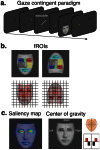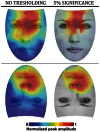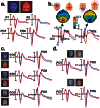Optimal eye-gaze fixation position for face-related neural responses
- PMID: 23762224
- PMCID: PMC3675086
- DOI: 10.1371/journal.pone.0060128
Optimal eye-gaze fixation position for face-related neural responses
Abstract
It is generally agreed that some features of a face, namely the eyes, are more salient than others as indexed by behavioral diagnosticity, gaze-fixation patterns and evoked-neural responses. However, because previous studies used unnatural stimuli, there is no evidence so far that the early encoding of a whole face in the human brain is based on the eyes or other facial features. To address this issue, scalp electroencephalogram (EEG) and eye gaze-fixations were recorded simultaneously in a gaze-contingent paradigm while observers viewed faces. We found that the N170 indexing the earliest face-sensitive response in the human brain was the largest when the fixation position is located around the nasion. Interestingly, for inverted faces, this optimal fixation position was more variable, but mainly clustered in the upper part of the visual field (around the mouth). These observations extend the findings of recent behavioral studies, suggesting that the early encoding of a face, as indexed by the N170, is not driven by the eyes per se, but rather arises from a general perceptual setting (upper-visual field advantage) coupled with the alignment of a face stimulus to a stored face template.
Conflict of interest statement
Figures






Similar articles
-
Effects of Inversion and Fixation Location on the Processing of Face and House Stimuli - A Mass Univariate Analysis.Brain Topogr. 2024 Nov;37(6):972-992. doi: 10.1007/s10548-024-01068-w. Epub 2024 Jul 23. Brain Topogr. 2024. PMID: 39042323
-
Fixation location on upright and inverted faces modulates the N170.Neuropsychologia. 2014 May;57:1-11. doi: 10.1016/j.neuropsychologia.2014.02.006. Epub 2014 Mar 4. Neuropsychologia. 2014. PMID: 24607846
-
One versus two eyes makes a difference! Early face perception is modulated by featural fixation and feature context.Cortex. 2018 Dec;109:35-49. doi: 10.1016/j.cortex.2018.08.025. Epub 2018 Sep 8. Cortex. 2018. PMID: 30286305
-
Face-related ERPs are modulated by point of gaze.Neuropsychologia. 2010 Oct;48(12):3657-60. doi: 10.1016/j.neuropsychologia.2010.07.020. Epub 2010 Jul 21. Neuropsychologia. 2010. PMID: 20654637 Free PMC article.
-
Understanding face perception by means of human electrophysiology.Trends Cogn Sci. 2014 Jun;18(6):310-8. doi: 10.1016/j.tics.2014.02.013. Epub 2014 Apr 1. Trends Cogn Sci. 2014. PMID: 24703600 Review.
Cited by
-
A link between individual differences in multisensory speech perception and eye movements.Atten Percept Psychophys. 2015 May;77(4):1333-41. doi: 10.3758/s13414-014-0821-1. Atten Percept Psychophys. 2015. PMID: 25810157 Free PMC article.
-
Effects of Inversion and Fixation Location on the Processing of Face and House Stimuli - A Mass Univariate Analysis.Brain Topogr. 2024 Nov;37(6):972-992. doi: 10.1007/s10548-024-01068-w. Epub 2024 Jul 23. Brain Topogr. 2024. PMID: 39042323
-
Fixation to features and neural processing of facial expressions in a gender discrimination task.Brain Cogn. 2015 Oct;99:97-111. doi: 10.1016/j.bandc.2015.05.007. Epub 2015 Aug 13. Brain Cogn. 2015. PMID: 26277653 Free PMC article.
-
Neural Correlates of Explicit Versus Implicit Facial Emotion Processing in ASD.J Autism Dev Disord. 2017 Jul;47(7):1944-1955. doi: 10.1007/s10803-017-3141-1. J Autism Dev Disord. 2017. PMID: 28497246
-
Early sensitivity for eyes within faces: a new neuronal account of holistic and featural processing.Neuroimage. 2014 Aug 15;97:81-94. doi: 10.1016/j.neuroimage.2014.04.042. Epub 2014 Apr 21. Neuroimage. 2014. PMID: 24768932 Free PMC article.
References
-
- Rossion B, Jacques C (2008) Does physical interstimulus variance account for early electrophysiological face sensitive responses in the human brain? ten lessons on the n170. NeuroImage 39: 1959–1979. - PubMed
-
- Jacques C, Rossion B (2007) Electrophysiological evidence for temporal dissociation between spatial attention and sensory competition during human face processing. Cereb Cortex 17: 1959–1979. - PubMed
-
- Jemel B, Schuller A, Cheref-Khan Y, Goffaux V, Crommelinck M, et al. (2003) Stepwise emergence of the face-sensitive n170 event-related potential component. Cereb Cortex 14: 2035–2039. - PubMed
-
- Haig N (1986) Exploring recognition with interchanged facial features. Perception 15: 505–512. - PubMed
Publication types
MeSH terms
LinkOut - more resources
Full Text Sources
Other Literature Sources

